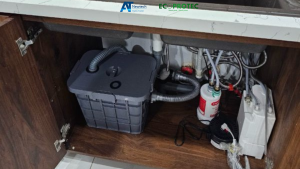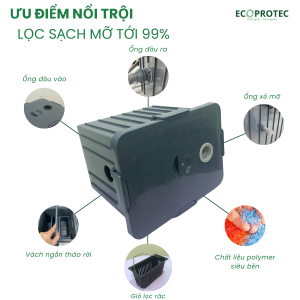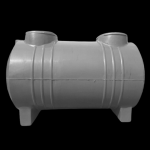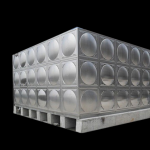Household Grease Trap: Should You Choose the Floating Type or the Under-Sink Type?
A household grease trap is an important device that helps separate grease from wastewater during cooking, reducing the risk of pipe blockages and protecting the environment. However, many people are still unsure whether to choose a floating grease trap or an under-sink grease trap. Each type has its own advantages and disadvantages, depending on specific usage needs. In this article, we will explore both options to help you choose the best product.
1. Introduction to Household Grease Traps
1.1. What is a Household Grease Trap?
A household grease trap is a device designed to separate grease and waste from wastewater before it is discharged into the drainage system. Using a grease trap helps prevent clogs, reduce odors, and protect the environment in the long term.
1.2. How Does a Household Grease Trap Work?
The grease trap works based on the principle of separation by gravity. Grease, being lighter than water, rises to the surface, while waste particles sink to the bottom. The cleaner water is then discharged through the drainage pipe.
2. What is a Floating Grease Trap? Advantages and Disadvantages
2.1. What is a Floating Grease Trap?

A floating grease trap is a device placed outside, on the ground, or on the kitchen floor, usually compact in size and easy to install without complex construction work.
2.2. Advantages
-
Easy Installation and Movement: No drilling or cutting is needed; it is installed directly on the outside.
-
Convenient Cleaning: The lid can be easily opened for regular cleaning.
-
Low Cost: The price is usually cheaper compared to the under-sink type.
2.3. Disadvantages
-
Takes up space: Placing it on the floor may affect the aesthetics of the kitchen if there isn’t enough space for proper arrangement.
-
Processing efficiency may be lower: The capacity is smaller compared to the under-sink grease trap, making it more suitable for smaller households.
3. What is an Under-Sink Grease Trap? Advantages and Disadvantages
3.1. What is an Under-Sink Grease Trap?

An under-sink grease trap is designed to be installed underneath the sink cabinet, helping to save space and maintain the aesthetics of the kitchen.
3.2. Advantages
-
Space-saving: Placed neatly under the sink, it does not affect the kitchen layout.
-
Good grease filtering efficiency: Larger capacity, suitable for large families.
-
Maintains kitchen aesthetics: Hidden under the sink, keeping the kitchen looking neat and tidy.
3.3. Disadvantages
-
Higher cost: Typically more expensive than the floating grease trap.
-
More complex installation: Requires suitable space under the sink for installation.
-
More difficult to clean: Located inside the cabinet, it requires disassembly for regular cleaning.
4. Which type of grease trap should you choose for your family?
4.1. When should you choose a floating grease trap?
-
You want to save costs.
-
You do not want complex installation.
-
You need easy mobility and frequent cleaning.
-
Your home has ample space, and you are not concerned about it taking up space.
4.2. When should you choose an under-sink grease trap?
-
You need an optimal aesthetic solution.
-
The kitchen is small, and you need to save space.
-
Your family has many members and requires a large capacity to handle grease effectively.
5. Some popular household grease trap models
At Ecoprotec, we provide a variety of high-quality grease traps for families with modern designs:
-
Floating household grease trap: Made from high-grade PP plastic and stainless steel 304, rust-resistant, with a compact capacity.

-
Under-sink household grease trap: High capacity, suitable for larger families.
Choosing a household grease trap whether floating or under-sink, depends on your usage needs, kitchen space, and budget. If you need more detailed advice, feel free to contact Ecoprotec via the hotline: 0368172226/0834473166 for dedicated support!
We hope this article helps you make the right choice for your kitchen. If you found it helpful, please share it so others can benefit as well!

 Composite Tank
Composite Tank Water tank cover.
Water tank cover. Kitchen equipment
Kitchen equipment Industrial water tank
Industrial water tank


